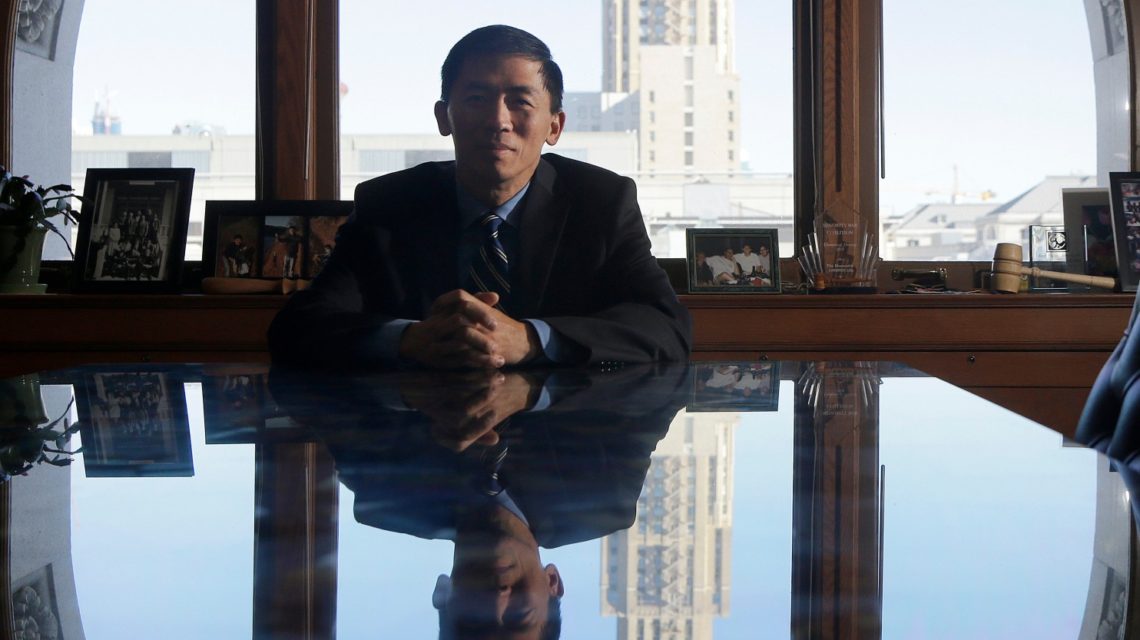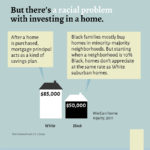By Tracy Jan
Wonkblog – The Washington Post, July 18, 2017 —
The question arose for California Supreme Court Justice Goodwin Liu when his court granted posthumous bar admission to Hong Yen Chang, a Chinese immigrant denied a law license more than a century ago because of his race: how are Asian Americans faring in the legal profession today?

California Supreme Court Justice Goodwin Liu in his office in San Francisco. Asians are the fastest-growing ethnic group in the U.S. but underrepresented in the leadership of the legal profession (AP Photo/Jeff Chiu)
Asian Americans are no longer subject to exclusion laws, but they have hit a legal glass ceiling in private practice, academia and public service.
While Asian Americans are the fastest growing minority group in law, and are overrepresented in the country’s top law schools as well as at major law firms, they lag behind all other racial groups when it comes to attaining leadership roles in the legal profession, according to a study released Tuesday by Yale Law School and the National Asian Pacific American Bar Association.
“Asian American growth in the legal profession has been impressive but penetration into leadership ranks has been slow,” said Liu, who co-authored the study with a group of students at Yale Law School, his alma mater.

Asian Americans comprise 10 percent of graduates at the country’s top law schools although they make up just 6 percent of the U.S. population. But only 3 percent of the federal judiciary and 2 percent of state judges are Asian American, the study found.
Of the 94 U.S. attorneys, only three are Asian American. And only four of the 2,437 elected prosecutors are Asian American.
In the private sector, Asian Americans have been the largest minority group in major law firms for nearly two decades, making up 7 percent of attorneys. But they have the highest attrition rates and the lowest ratio of partners to associates of any racial group.
And in academia, Asian made up only 3 out of 202 law school deans in the country in 2013, and 18 out of 709 associate or vice deans.
“Asian Americans do well when it comes to competition and selection with objective metrics” such as LSAT scores and grades, Liu said. “But when the selection begins to involve things that are intangible for promotions, they kind of flip off the radar.”



The disparities become evident straight out of law school. Asian Americans make up just 6.5 percent of federal judicial law clerks and 4.6 percent of state law clerks, despite their heavy presence at the top 30 law schools.
In contrast, while whites make up 58.2 percent of students at top law schools, they landed 82.4 percent of all federal clerkships and 80.2 percent of state clerkships.
This could be because professors often serve as the gateway to such opportunities, Liu said, and Asian American students may not have cultivated as strong ties with faculty given that most of them are white.
“Who do they think of as their proteges? Who do they mentor and decide to encourage?” Liu said. “In this very discretionary subjective selection process that involves having contacts, Asian Americans don’t do as well.”
Other students though simply know what to do. “They knew what a clerkship was — that it was something to go for and could open more doors for you later on in life,” Liu said. “They know how to seek out the professors who know the judges. You have to be part of that conversation and that network to know these things. There is no published manual.”

Left to right, California Supreme Court Justice Goodwin Liu with his co-authors, Yale Law School graduates Xiaonan April Hu, Christine Kwon and Eric Chung. (Photo courtesy of Goodwin H. Liu)
Eric Chung, a 24-year-old Yale Law graduate who co-authored the study, is clerking for Liu, having gotten to know him through their work in the report.
“For many Asian Americans, the traditional dynamic is just put your head down, do the good work, and it’s not who you know but how hard you work and what you do,” Chung said. “But in a society where a lot depends on these informal networks, that may not be sufficient.”
Similar patterns turn up in law firms when it comes to promotions, and candidates are evaluated on criteria like leadership, likability, sociability, gravitas and access to contacts, Liu said.
Implicit biases contribute to firms’ decisions about placing lawyers with clients and on the management committee, or naming as general counsel, he said.
“You hear a lot of recruiters talk about how we are one of the top two candidates but ultimately we weren’t the right ‘fit,’” said Jean Lee, president and chief executive of the Minority Corporate Counsel Association and a former vice president and assistant general counsel at JP Morgan Chase. “One of the primary factors is we’re not seen as leaders.”

Liu said the report, based on a survey, focus groups, and an analysis of publicly available data, is the first comprehensive look at Asian Americans in law.
He said he hopes the legal community will use the results to stimulate conversations about improving mentorship of law students and law firm associates, as well as to make people aware of existing biases.
“You have to give people hard numbers to show people that this is an issue,” Liu said.
WATCH VIDEO: The Myth of the Model Minority
The report’s findings, he said, turns the Asian “model minority” myth on its head. “People think Asian Americans are doing so well. But when you look at the top rungs, Asian Americans aren’t doing well at all.”










